A mechanical movement is the living, beating heart of every timepiece. Every “epoque” left behind its own distinctive design language. The style of the engravings changed over time as well as the adornments of the bridges. Just like in architecture and industrial design, the form went from highly decorative to reduced and simplistic. But the modifications were not only of cosmetical nature. New technologies and materials were introduced as well, in order to improve the accuracy and durabilty of the movements.
Most vintage Panerai watches were made by Rolex and were equipped with a variety of state of the art movements at the time they were produced. All these large and hand-wound calibers have their roots in the 1920’s and 1930’s and were derived not only from pocket watch movements but also from alarm clocks. They were specially modified for the usage in wristwatches. These reliable workhorses were supplied by the most renowned movement manufacturers of Switzerland and play a significant role in the beauty and value of Vintage Panerai watches.
The following list is the result of years of meticulous research and an attempt to describe each caliber and its variations and link them in chronological order to the corresponding reference.
Montilier 663
According to some Rolex receipts found by Mr. Ferretti in Giuseppe Panerai’s office in 2010 the movements used in Ref. 2533 were described as 16 3/4 Ligne. This leads to the assumption that this reference was originally equipped with Rolex 663 Extra Prima units supplied by Montilier. This movement was available in many different sizes and with 5 different bridge layouts.

The caliber number 663 consists of bridge layout No. 6 and size 63 (16 3/4 Ligne)
This type of caliber is known to be quite complicated and fragile. It might have been a good choice for pocket watches but most probably inadequate for the usage in military wristwatches due to its fragility.
Ref. 2533
Ref. 2533 – Rolex 663 Extra Prima supplied by Montilier (1935)
There are only 2 known watches of Ref. 2533 until now. According to their case numbers both watches were produced in 1939. One of them has a Rolex 618 Type 1b from 1944 which makes it obvious that the movement was exchanged at some point. The second watch has the – in my opinion – correct Rolex 663 Extra Prima caliber.
According to the serial number 7X2.52X the production date of this movement is most certainly 1925/26. Important parts of the micro regulation system on the balance cock are missing.

- 16 3/4 Ligne
- 17 Jewels
- Micro regulation (Swan neck)
- Screwed chatons
- Breguet overcoil hairspring
- 18.000 A/h (Alternances par heur, semi oscillations per hour)
Montilier 663 in pocket watches
This type of movement was already used by Rolex in 1925/26 for their Rolex Oyster pocket watches. The serial number of this movement is 776.486.

Cortebert 618
The first exclusively for Panerai produced Reference 3646 was equipped with highly elaborated Cortebert Cal. 618 16 Ligne movements with 17 Jewels and fully jeweled escapement wheel. Cal. 618 shares the same main plate with Cal. 616. This caliber was developed around 1932 as a more robust option to the thin Cal. 620/622. It was offered with 2 different bridge layouts. The balance cock had the typical AR/FS (avant, retard/fast, slow) engravings and the bridges were decorated with 7 stripes of Côtes de Genève (Geneva stripes).

Cortebert had already supplied various calibers to Rolex for the usage in small dress pocket watches. Cal. 492/514 for instance can be found in early “Eaton Quarter Century Club” award watches. From 1928 to late 1940’s they also used Cal. 622 in a highly elaborated and decorated version with 17 Jewels. This calibers were equipped with an “Elinvar” Breguet overcoil hairspring. Cal. 622 shares the same main plate with Cal. 620 and is a lot thinner than Cal. 616/618.
.
Ref. 3646
Ref. 3646 Type A, B, C – Rolex 618 Type 1a (supplied by Cortebert 1939)
The first series of Rolex 618 movements installed in Ref 3646 had Rolex engravings which followed the upper curve of the train bridge.
Serial numbers: 7.500.000 – 7.515.999
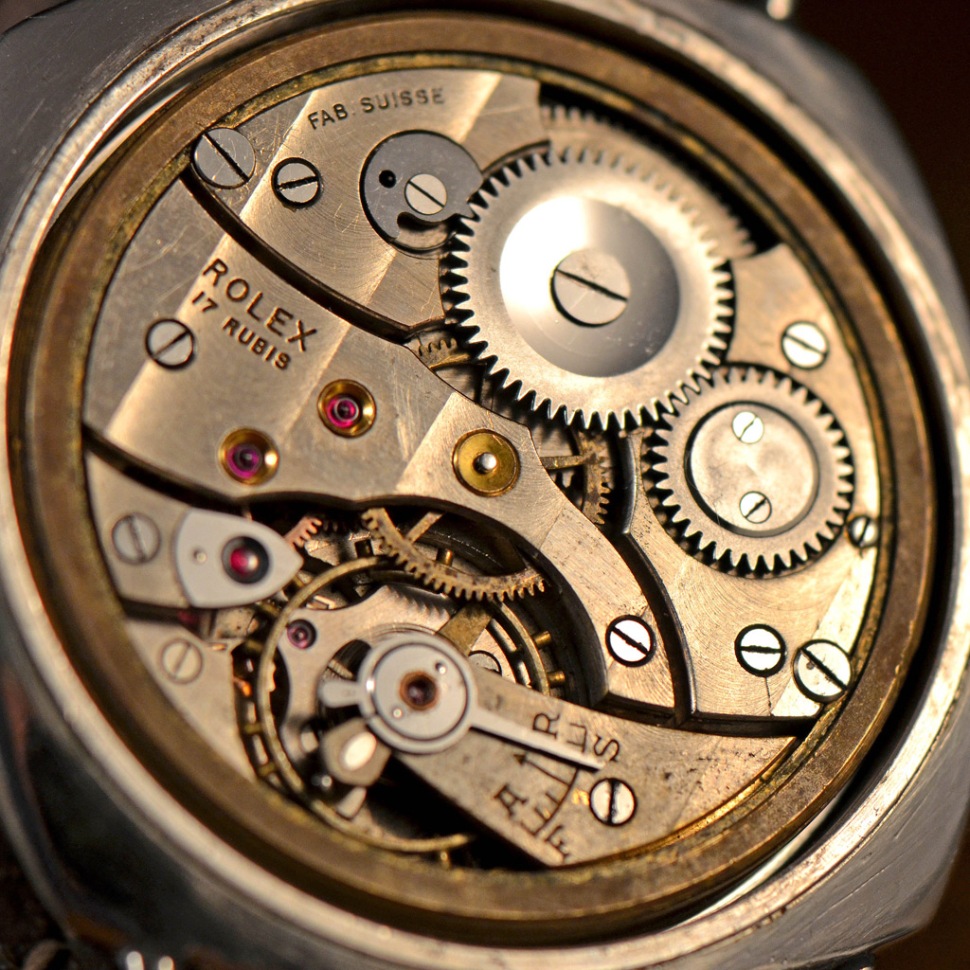
- 16 Ligne
- 17 Jewels
- Fully jeweled escapement wheel
- Breguet overcoil hairspring
- 18.000 A/h (Alternances par heur, semi oscillations per hour)
.
Where are the 17 jewels located?
1 x Impulse pin
2 x Pallets (Pallet fork aka lever)
2 x Balance staff bearings
2 x Balance staff capstones
2 x Lever bearings (Pallet fork)
2 x Escapement wheel bearings
2 x Escapement wheel capstones (polished cap on escapement wheel bridge)
2 x Fourth wheel bearings
2 x Third wheel bearings
.
3646 Type D – Rolex 618 Type 1b (supplied by Cortebert 1944)
3646 of Type D had a movement with slightly different engravings than the earlier version. The Rolex engravings are straight and the A in Fab. Suisse has a different shape.
Serial numbers: 7.519.000 – 7.519.999
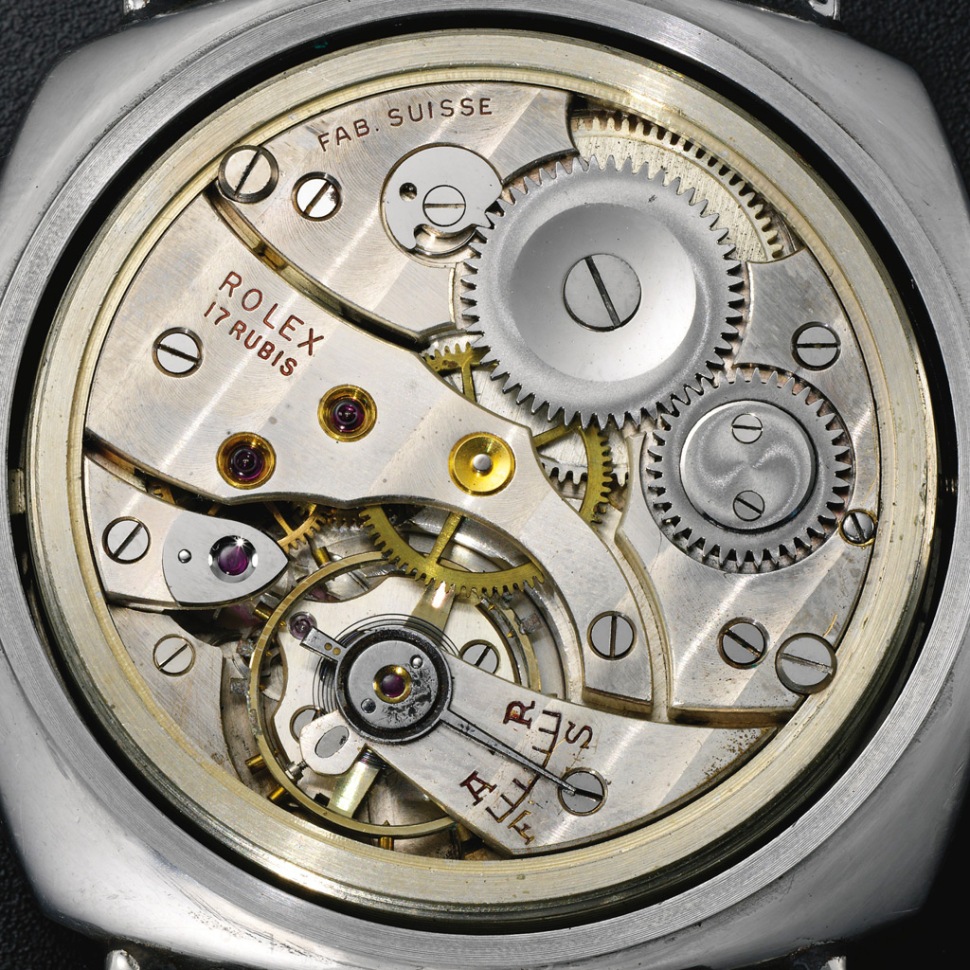
- 16 Ligne
- 17 Jewels
- Fully jeweled escapement wheel
- Breguet overcoil hairspring
- 18.000 A/h (Alternances par heur, semi oscillations per hour)
.
Main differences between Rolex 618 Type 1a and Type 1b
On the following picture the differences are pretty obvious. Early movements have engravings which follow the upper curve (1) of the train bridge while later engravings are completely straight (2).
Another difference is the shape of the letter A (3) in “Fab. Suisse”. On early movements both stems of the letter A form a pointy apex. On later units the stems are connected by a horizontal bar. Kerning and size of the letters are bigger on later movements.
.
3646 Type E – G, Rolex 618 Type 1 anonymous (supplied by Cortebert 1944)
This group of watches used a movement variation which was completely unbranded. Most cases did not have any “Rolex” inscription either. Only the case number was stamped. We can only speculate as to why this was done. Some say it was done to conceal the identity of the frogman in case of being captured. Considering the Nazi combat swimmer had a special rubber bag in which they carried their ID card, this assumption makes not much sense.
I believe Rolex had a long-term agreement with G. Panerai e Figlio. But they got wind of the fact that a large number of watches had been given to the Nazis and they simply did no longer want to appear openly as the supplier of those timepieces. Most swiss watch brands supplied watches to both side of the conflict. Rolex was no exception.
Serial numbers: 7.527.500 – 7.528.500

- 16 Ligne
- 17 Jewels
- Fully jeweled escapement wheel
- Breguet overcoil hairspring
- 18.000 A/h (Alternances par heur, semi oscillations per hour)
There are examples of this type with “Rolex” engravings on the arch of the train bridge. I believe these engravings are not original and were added in the 1980’s and 1990’s when the value of these watches was low and people wanted to show they own a Rolex watch. I noticed that every inscription is different. Some are even executed in a very amateurish way.

.
The main plate of Type 1 movements
Here is a view on the main plate of Type 1 movements. 17 Jewels units have a fully jeweled escapement wheel and therefore an additional capstone near the capstone for the balance wheel.
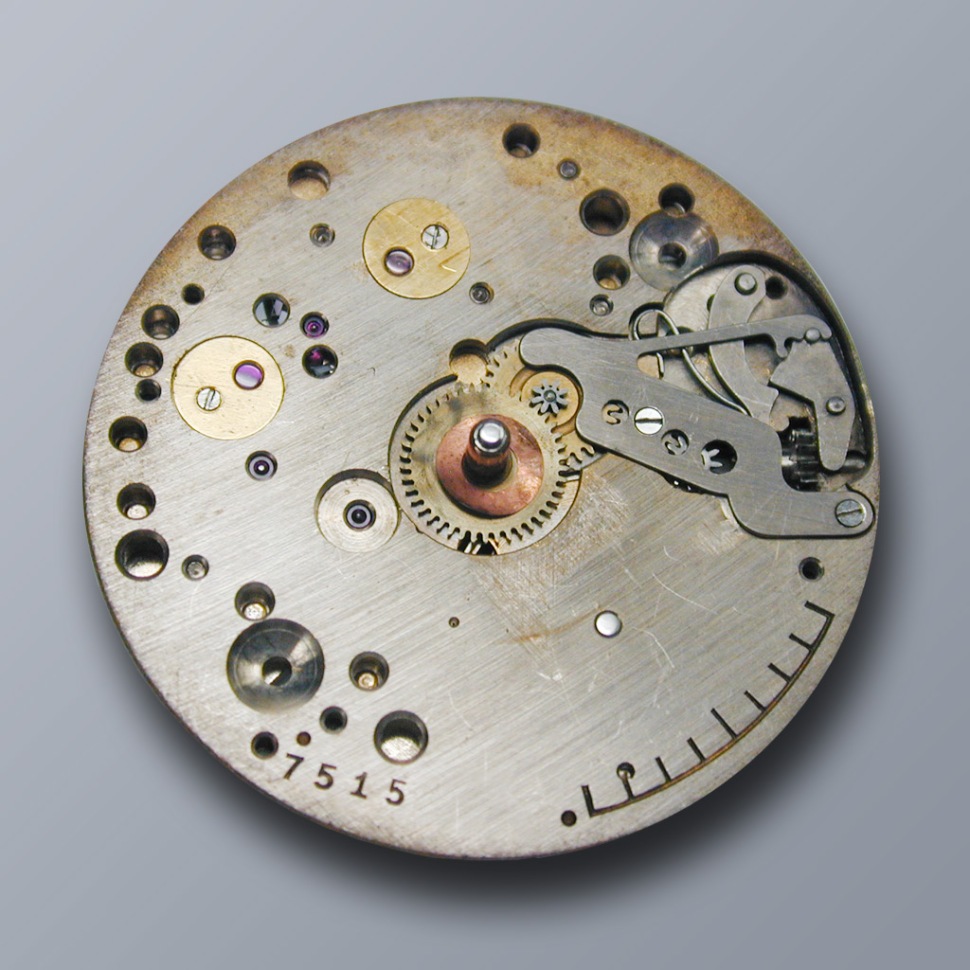
.
Rolex 618 in pocket watches
For a long time it was believed that Rolex 618 units were exclusively produced for the usage in Vintage Panerai watches. This is definitely not true. I have found several Rolex pocket watches with proper Rolex 618 movements with 15 Jewels. The oldest of them had Glasgow import hallmarks with date letter [k] from 1933.
These calibers are not to be confused with the slimmer Rolex 622 “Elinvar” used in so many Rolex pocket watches from the early 1930’s.

Here is a comparison of a Cortebert 616 with such a Rolex 618 from a pocket watch. They are the same size and same height.
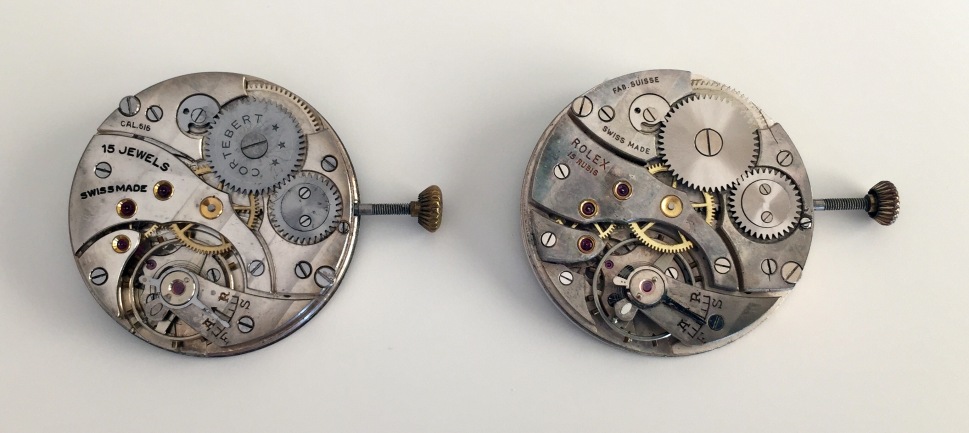

Rolex 618 after WW2
Rolex 618 units produced after WW2 had a slightly different look. An increased international demand for watches during and after WW2 made it necessary to simplify the movement regulating instructions on the balance cock. Instead of AR/FS (avant, retard/fast, slow) the balance cock now bore the easy to understand symbols +/-. This update gives the movements a more modern look. The Côtes de Genève (Geneva stripes) became slightly broader and only 5 stripes were applied. Ratchet and crown wheels received a simpler finish without the swirls.
Cortebert ceased to stamp serial numbers by the end of WW2.
Ref. 6152
Ref. 6152 – Rolex 618 Type 2a (supplied by Cortebert 1953)
Reference 6152 from 1953 was equipped with a Rolex 618 Type 2a with only 15 Jewels. According to Mr. Ferretti only 24 pieces of this reference were produced. He said this information was provided by Rolex S.A.

- 16 Linge
- 15 Jewels
- Breguet overcoil hairspring
- Balance cock +/-
- with/without Cort stamp underneath the Balance
- 18.000 A/h (Alternances par heur, semi oscillations per hour)
Ref. 6152 – Rolex 618 Type 2 “Transitional” (supplied by Cortebert)
The following caliber was found in a Ref. 6152 and is unique. It has a Cort stamp underneath the balance but no Incabloc shock protection. All engravings were applied to the barrel bridge.
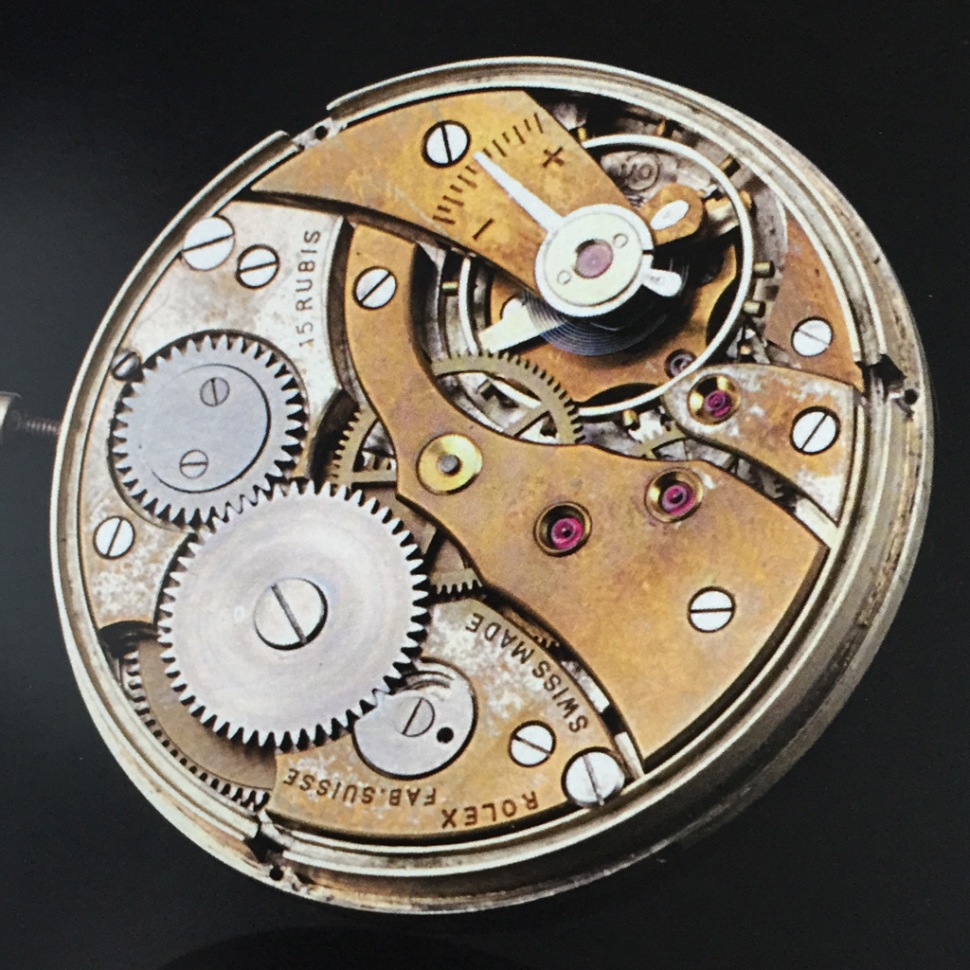
- 16 Linge
- 15 Jewels
- Breguet overcoil hairspring
- Balance cock +/-
- Cort stamp underneath the Balance
- 18.000 A/h (Alternances par heur, semi oscillations per hour)
Ref. 6154
Ref. 6154 – Rolex 618 Type 2b (supplied by Cortebert 1954)
Reference 6154 from 1954, which was produced in 36 pieces according to Mr. Ferretti, was most certainly equipped with an updated version of Rolex 618 Type 2a. There are units with and without Incabloc shock protection.

- 16 Linge
- 15 Jewels
- Breguet overcoil hairspring
- Balance cock +/-
- Cort stamp underneath the Balance
- with/without Incabloc shock protection
- 18.000 A/h (Alternances par heur, semi oscillations per hour)
Ref. 6154 – Rolex 618 Type 2c (supplied by Cortebert 1954)
Reference 6154 from 1954 was also equipped with a this version of the Rolex 618. In my opinion this was the original movement with which reference 6154 was equipped by Rolex. All movements of this type have Incabloc shock protection.

- 16 Linge
- 15 Jewels
- Breguet overcoil hairspring
- Balance cock +/-
- Cort stamp underneath the Balance
- Incabloc shock protection
- 18.000 A/h (Alternances par heur, semi oscillations per hour)
20 watches of reference 6154 are known until today. There are 7 or 8 different movements in these watches. This is an unusual pattern for Rolex considering they always delivered state of the art watches. Among them are some Type 1b, Type 1 anonymous and even a Rolex 622 from a pocket watch. These movements were most certainly replaced.
Ref. 6152 1
Ref. 6152 1 – Rolex 618 Type 3 (supplied by Cortebert 1955)
A few watches of Ref. 6152 1 are equipped with Rolex 618 movements with only 15 Jewels.

- 16 Linge
- 15 Jewels
- Breguet overcoil hairspring
- Balance cock +/-
- Cort stamp underneath the Balance
- Incabloc shock protection
- 18.000 A/h (Alternances par heur, semi oscillations per hour)
Ref. 6152 1 – Rolex 618 Type 4 (supplied by Cortebert 1955)
This is the typical movement of Ref. 6152 1. It came again with 17 Jewels like the early versions. This leads to the assumption that all movements of Type 2 and 3 might have been simple versions for test purposes.
One jewel was added to the train bridge for the centre wheel and another one to the escapement bridge as cap stone for the escapmenet wheel (1 side only). Unlike early Rolex 618 Type 1 movements the escapement wheel is not fully jeweled. The Balance wheel of these movement is made from Glucydur.

- 16 Linge
- 17 Jewels
- Breguet overcoil hairspring
- Glucydur Balance wheel
- Balance cock +/-
- Cort stamp underneath the Balance
- Incabloc shock protection
- Cap stone for escapement wheel (1 side only)
- 18.000 A/h (Alternances par heur, semi oscillations per hour)
.
Where are the 17 jewels located?
1 x Impulse pin
2 x Pallets (Pallet fork aka lever)
2 x Balance staff bearings
2 x Balance staff capstones
2 x Lever bearings (Pallet fork)
2 x Escapement wheel bearings
1 x Escapement wheel capstones (polished cap on escapement wheel bridge)
2 x Fourth wheel bearings
2 x Third wheel bearings
1 x Center wheel bearing (train gear bridge)
.
The main plate of modern movements
This is how the main plate of Type 4 movements looks like. There is no serial number anymore and the Incabloc shock protection required an additional slot compared to regular movements.

Modern Rolex 618 in pocket watches
Similar Rolex 618 movements with Incabloc can be found in Rolex Pocket watches. These watches are very rare but they certainly exist.

Evolution of Cal. 616 compared to Cal. 618
The following chart illustrates the evolution of Cortebert Cal. 616 compared to Rolex Cal. 618.

Angelus 240
Rolex 618 movements had a power reserve of only 38 hours. Daily winding was affecting the crown threads and sealing gaskets. Panerai decided to replace some of the Rolex 618 movements in Ref. 6152 1 with Angelus 240 8-day calibers in order to reduce stress on the winding group to once a week.
In “Panerai – Una storia Italiana” it is written that approximately 80 – 100 Ref. 6152 1 watches were modified. It would certainly be interesting to learn where all the replaced Rolex 618 ended up.
Angelus produced in 1955 and 1961 a series of non-alarm crown-wind movements with 17 Jewels specifically developed for the use in wrist watches on special request of Guido Panerai e Figlio. These movements were assembled using old non-alarm barrel plates recognizable by the old “waved” design. In order to take the long-click these old plates had to be slightly modified.
Panerai used Angelus 240 mechanisms marked 12.55 on the GPF 2/56 and replaced many Rolex 618 movements on reference 6152/1 with Cal. 240 marked either MAI.61 or JUIN.61.
Read more about the evolution of the Angelus 240 caliber
GPF 2/56
GPF 2/56 – Angelus 240 (supplied by Angelus 1956)
Angelus 240 used in the GPF 2/56 had a brushed finish and were equipped with the Incastar micro regulation system. The movement had 17 Jewels instead of the regular 15 of alarm clocks and a Glucydur balance wheel. The production date of these movements is stamped on the main plate. This batch was produced in December 1955 (12.55).

- 16 Linge
- 17 Jewels
- 8 days power reserve
- Glucydur Balance wheel
- Incastar micro regulation
- Incabloc shock protection
- 18.000 A/h (Alternances par heur, semi oscillations per hour)
Ref. 6152 1 Modified
Ref. 6152 1 – Angelus 240 (supplied by Angelus 1961)
Ref. 6152 1 was modified in order to take the new Angelus movement. A new movement ring had to be produced. Due to the pillar construction these movement suffer from vertical pressure. The Rolex engravings on the casebacks of some watches were removed. I believe this was also done to deal with the pressure issue.
Angelus changed the finish to Côtes de Genève. These units were produced in two batches in May and June 1961 (MAI.61, JUIN.61).

- 16 Linge
- 17 Jewels
- 8 days power reserve
- Glucydur Balance wheel
- Incabloc shock protection
- 18.000 A/h (Alternances par heur, semi oscillations per hour)
There are other variations of the Angelus 240 found in some Vintage Panerai watches. Some of them are obvious conversions from alarm clocks. They were either made to replace a broken movement or for other reasons.
The evolution of the Angelus 240
The following chart illustrates the major steps in the evolution of the Angelus 240.

Thanks for your interest!


